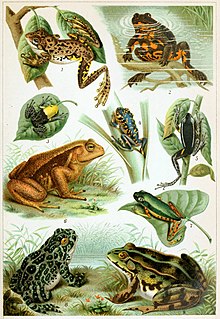Rueppel’s big-eyed tree frog is a species of frog in the family Hylidae. It is endemic to Indonesia. Its natural habitats are subtropical or tropical moist lowland forests, subtropical or tropical moist montane forests, and rivers. It is threatened by habitat loss.
The Alhandra heart-tongued frog is a species of frog in the family Hylidae endemic to Brazil. Its natural habitats are subtropical or tropical moist lowland forests and subtropical or tropical moist shrubland. The frogs are threatened by habitat loss.

Phyllomedusa trinitatis is a species of frog in the family Hylidae. It is found in Trinidad and Tobago and Venezuela. Its natural habitats are subtropical or tropical moist lowland forests, subtropical or tropical moist montane forests, moist savanna, subtropical or tropical moist shrublands, freshwater marshes, heavily degraded former forests, ponds, and canals and ditches. It is threatened by habitat loss.
Bokermann's casque-headed tree frog is a species of frog in the family Hylidae endemic to Brazil. Its natural habitats are subtropical or tropical dry forests, moist savanna, subtropical or tropical dry shrubland, and intermittent freshwater marshes. It is threatened by habitat loss.
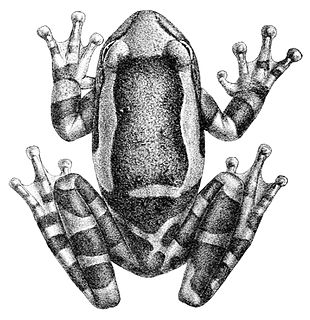
The Surinam golden-eyed tree frog is a species of frog in the family Hylidae found in Bolivia, Brazil, Ecuador, French Guiana, Peru, Suriname, and possibly Colombia. Its natural habitat is subtropical or tropical moist lowland forests. It is threatened by habitat loss.
The New River tree frog is a species of frog in the family Hylidae found in French Guiana, Guyana, Suriname, and possibly Brazil. Its natural habitat is subtropical or tropical moist lowland forests.
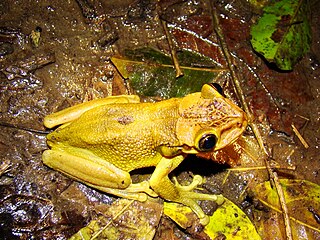
Jordan's casque-headed tree frog is a species of frog in the family Hylidae found in Colombia, Ecuador, and Peru. Its natural habitats are subtropical or tropical dry forests, subtropical or tropical moist lowland forests, intermittent freshwater marshes, plantations, rural gardens, urban areas, and heavily degraded former forests. It is threatened by habitat loss.
Trachycephalus lepidus is a species of frogs in the family Hylidae endemic to Brazil. Its natural habitat is subtropical or tropical moist lowland forests. It is threatened by habitat loss. This species was previously within the genus Phrynohyas, which was recently synonymized with Trachycephalus.

The Porto Alegre golden-eyed tree frog is a species of frog in the family Hylidae endemic to Brazil. Its natural habitats are subtropical or tropical moist lowland forests, freshwater marshes, and intermittent freshwater marshes. It is threatened by habitat loss.
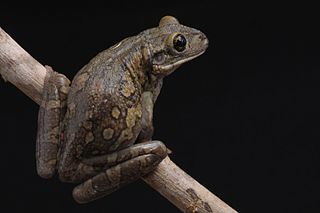
The black-spotted casque-headed tree frog is a species of frog in the family Hylidae endemic to Brazil. Its natural habitats are subtropical or tropical moist lowland forests, subtropical or tropical moist shrubland, freshwater lakes, intermittent freshwater lakes, freshwater marshes, intermittent freshwater marshes, rural gardens, and heavily degraded former forests. It is threatened by habitat loss.

The veined tree frog or common milk frog, Trachycephalus venulosus, is a species of frog in the family Hylidae. This species was previously within the genus Phrynohyas, which was recently synonymized with Trachycephalus . It is found in Argentina, Belize, Bolivia, Brazil, Colombia, Costa Rica, Ecuador, El Salvador, French Guiana, Guatemala, Guyana, Honduras, Mexico, Nicaragua, Panama, Paraguay, Peru, Suriname, Trinidad and Tobago, and Venezuela. Its natural habitats are subtropical or tropical dry forest, subtropical or tropical moist lowland forest, subtropical or tropical moist shrubland, subtropical or tropical dry lowland grassland, rivers, intermittent rivers, freshwater lakes, freshwater marshes, intermittent freshwater marshes, arable land, pastureland, plantations, rural gardens, urban areas, heavily degraded former forest, water storage areas, and ponds.
The Rio Pitzara robber frog, Strabomantis helonotus, is a species of frog in the Craugastoridae family. It is endemic to Ecuador. Its natural habitats are subtropical or tropical moist lowland forests and subtropical or tropical moist montane forests. It is threatened by habitat destruction.
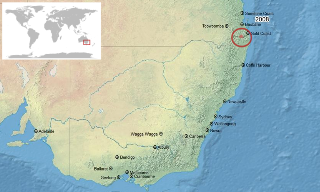
The Loveridge's frog, also known as the masked mountain frog, is a species of frogs in the family Myobatrachidae.

The Eungella tinker frog, Liem's frog, or Liem's tinker frog is a species of frog in the family Myobatrachidae. It is endemic to Australia. Its natural habitats are subtropical or tropical moist lowland forests, subtropical or tropical moist montane forests, rivers, and intermittent rivers. It is threatened by habitat loss.
The long-snout torrent frog is a species of frogs in the family Ranidae.

The island forest frog is a species of frog in the family Ceratobatrachidae. It is endemic to the Philippines. It is found only on South Gigante Island just northeast of Panay, where it inhabits limestone karst habitats.
The smooth-skinned forest frog is a species of frog in the family Ceratobatrachidae. It is endemic to Romblon, Philippines. It occurs on Sibuyan Island, and may also occur on other nearby islands.
Odorrana junlianensis is a species of frogs in the family Ranidae that is found in Guizhou, Yunnan and Sichuan in China as well as in the northernmost Laos and Vietnam. Its type locality is Junlian County in Sichuan.
The Zhenhai brown frog is a species of frog in the family Ranidae found in China and possibly Hong Kong and Macau. Its natural habitats are subtropical or tropical moist lowland forests, subtropical or tropical moist montane forests, subtropical or tropical dry lowland grasslands, intermittent freshwater marshes, ponds, and irrigated land. It is not considered threatened by the IUCN.
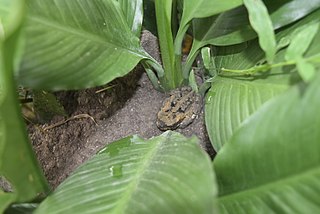
The Mindoro tree frog is a species of frog in the family Rhacophoridae. It is endemic to the Philippines.

